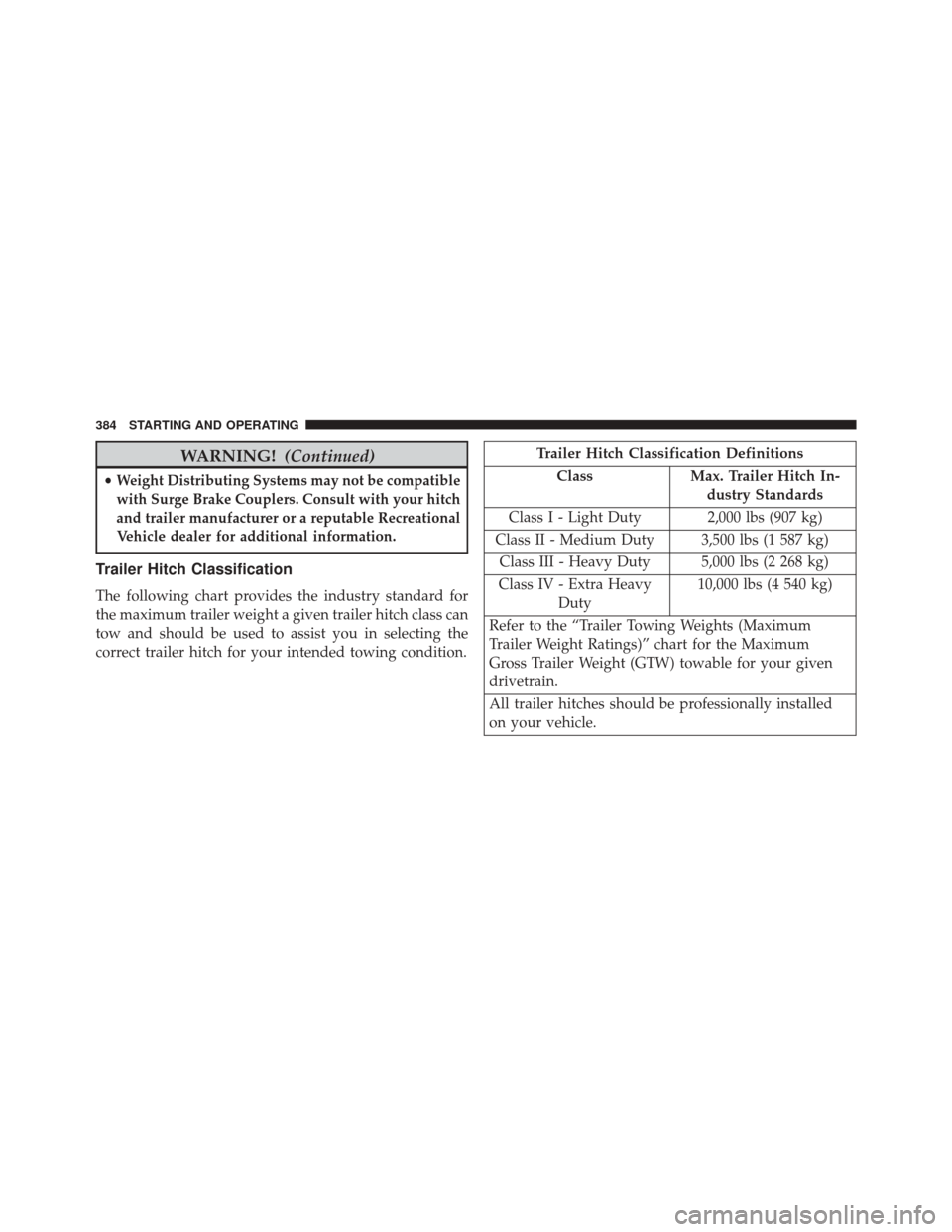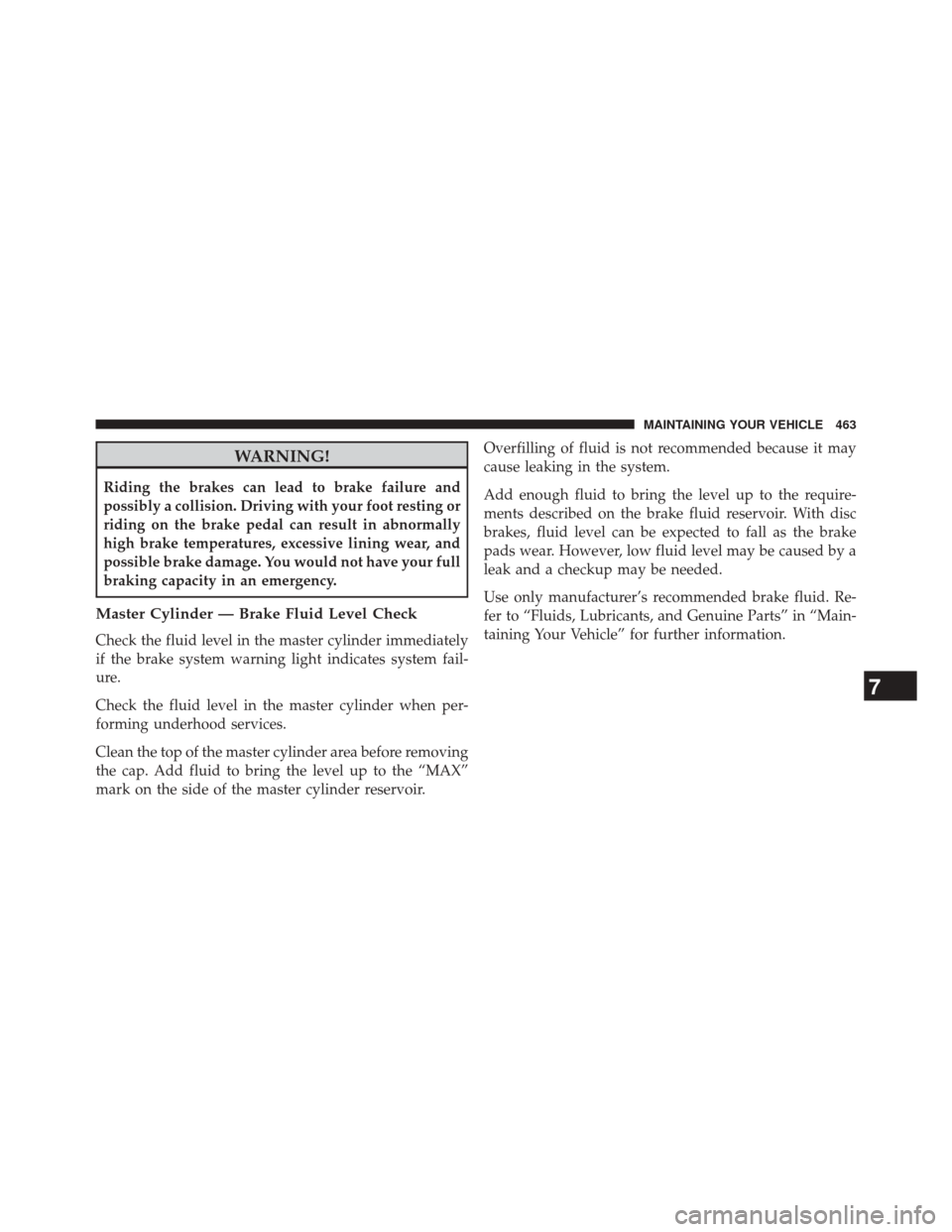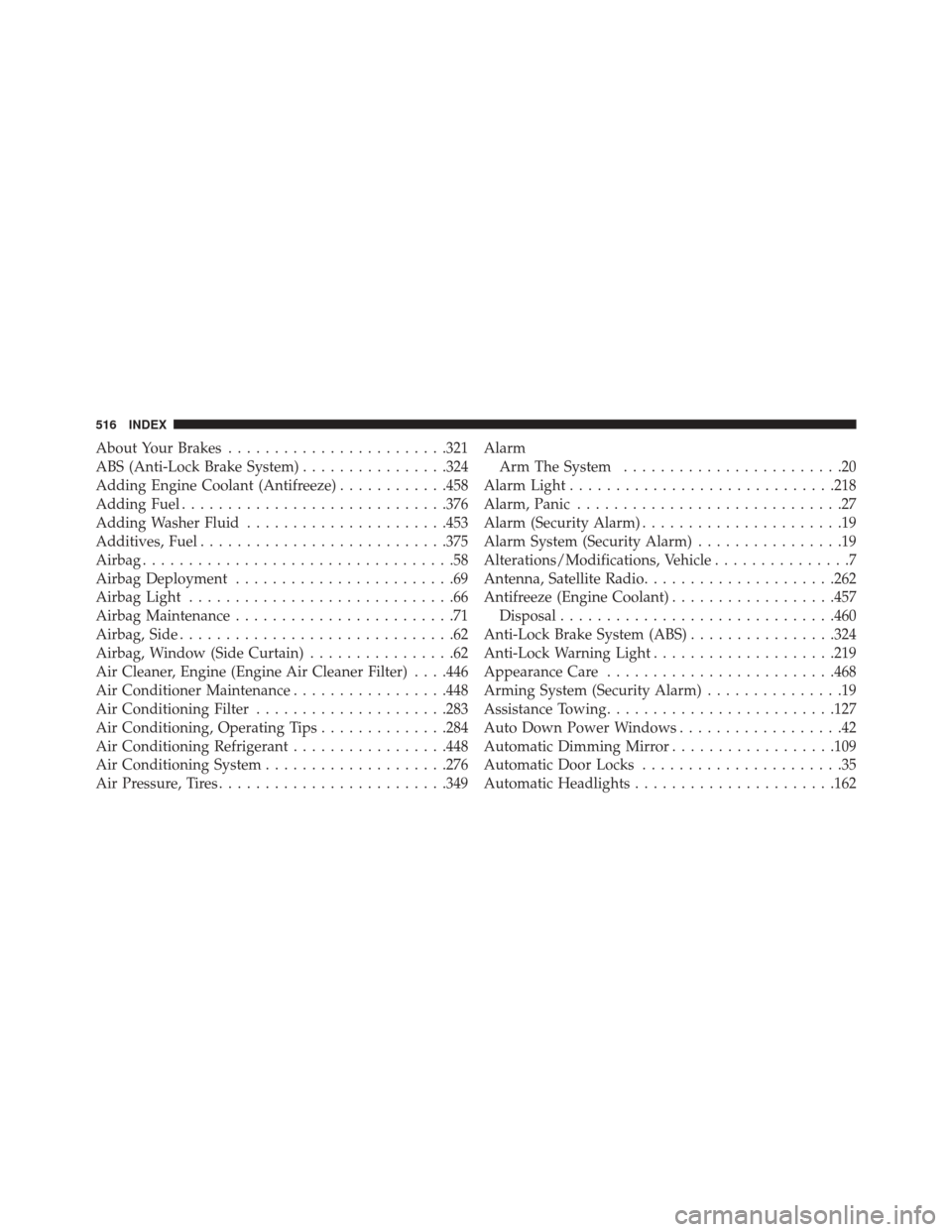Page 333 of 539

8. Rotate the steering wheel back to center and then anadditional half-turn to the right.
9. Turn the ignition switch to the OFF position and then back to the ON position. If the sequence was com-
pleted properly, the “ESC Activation/Malfunction In-
dicator Light” will blink several times to confirm HSA
is disabled.
10. Repeat these steps if you want to return this feature to it’s previous setting.
Electronic Stability Control (ESC)
This system enhances directional control and stability of
the vehicle under various driving conditions. The ESC
corrects for oversteering and understeering the vehicle
by applying the brake of the appropriate wheel. Engine
power may also be reduced to assist in counteracting the
condition of oversteer or understeer and help the vehicle
maintain the desired path. The ESC uses sensors in the vehicle to determine the path
that the driver intends to steer the vehicle and compares
it to the actual path of the vehicle. When the actual path
does not match the intended path, the ESC applies the
brake of the appropriate wheel to assist in counteracting
the condition of oversteer or understeer.
•
Oversteer - when the vehicle is turning more than
appropriate for the steering wheel position.
• Understeer - when the vehicle is turning less than
appropriate for the steering wheel position.WARNING!
The Electronic Stability Control System (ESC) cannot
prevent the natural laws of physics from acting on
the vehicle, nor can it increase the traction afforded
by prevailing road conditions. ESC cannot prevent
(Continued)
5
STARTING AND OPERATING 331
Page 386 of 539

WARNING!(Continued)
•Weight Distributing Systems may not be compatible
with Surge Brake Couplers. Consult with your hitch
and trailer manufacturer or a reputable Recreational
Vehicle dealer for additional information.
Trailer Hitch Classification
The following chart provides the industry standard for
the maximum trailer weight a given trailer hitch class can
tow and should be used to assist you in selecting the
correct trailer hitch for your intended towing condition.
Trailer Hitch Classification Definitions
Class Max. Trailer Hitch In-
dustry Standards
Class I - Light Duty 2,000 lbs (907 kg)
Class II - Medium Duty 3,500 lbs (1 587 kg) Class III - Heavy Duty 5,000 lbs (2 268 kg)
Class IV - Extra Heavy Duty 10,000 lbs (4 540 kg)
Refer to the “Trailer Towing Weights (Maximum
Trailer Weight Ratings)” chart for the Maximum
Gross Trailer Weight (GTW) towable for your given
drivetrain.
All trailer hitches should be professionally installed
on your vehicle.
384 STARTING AND OPERATING
Page 392 of 539
CAUTION!(Continued)
could lead to accelerated brake lining wear, higher
brake pedal effort, and longer stopping distances.
Towing Requirements — Trailer Lights And Wiring
Whenever you pull a trailer, regardless of the trailer size,
stoplights and turn signals on the trailer are required for
motoring safety.
The Trailer Tow Package may include a four- and seven-
pin wiring harness. Use a factory approved trailer har-
ness and connector.
NOTE:Do not cut or splice wiring into the vehicles
wiring harness.
The electrical connections are all complete to the vehicle
but you must mate the harness to a trailer connector.
Refer to the following illustrations.
Four-Pin Connector
1 — Female Pins 4 — Park
2 — Male Pin 5 — Left Stop/Turn
3 — Ground 6 — Right Stop/Turn
390 STARTING AND OPERATING
Page 465 of 539

WARNING!
Riding the brakes can lead to brake failure and
possibly a collision. Driving with your foot resting or
riding on the brake pedal can result in abnormally
high brake temperatures, excessive lining wear, and
possible brake damage. You would not have your full
braking capacity in an emergency.
Master Cylinder — Brake Fluid Level Check
Check the fluid level in the master cylinder immediately
if the brake system warning light indicates system fail-
ure.
Check the fluid level in the master cylinder when per-
forming underhood services.
Clean the top of the master cylinder area before removing
the cap. Add fluid to bring the level up to the “MAX”
mark on the side of the master cylinder reservoir.Overfilling of fluid is not recommended because it may
cause leaking in the system.
Add enough fluid to bring the level up to the require-
ments described on the brake fluid reservoir. With disc
brakes, fluid level can be expected to fall as the brake
pads wear. However, low fluid level may be caused by a
leak and a checkup may be needed.
Use only manufacturer’s recommended brake fluid. Re-
fer to “Fluids, Lubricants, and Genuine Parts” in “Main-
taining Your Vehicle” for further information.
7
MAINTAINING YOUR VEHICLE 463
Page 499 of 539

Severe Duty All Models
Change Engine Oil at 4000 miles (6,500 km) if the vehicle
is operated in a dusty and off road environment. This
type of vehicle use is considered Severe Duty
Once A Month Or Before A Long Trip:
•Check engine oil level
• Check windshield washer fluid level
• Check tire pressure and look for unusual wear or
damage. Rotate tires at the first sign of irregular wear,
even if it occurs before your next scheduled service.
• Check the fluid levels of the coolant reservoir, brake
master cylinder, and power steering and fill as needed.
• Check function of all interior and exterior lights Required Maintenance Intervals.
Refer to the maintenance schedules on the following
page for the required maintenance intervals.
At Every Oil Change Interval As Indicated By Oil
Change Indicator System:
•Change oil and filter
•
Rotate the tires.Rotate at the first sign of irregular
wear, even if it occurs before your next scheduled service
• Inspect battery and clean and tighten terminals as
required
• Inspect brake pads, shoes, rotors, drums, hoses
and park brake
•
Inspect engine cooling system protection and hoses
• Inspect exhaust system
• Inspect engine air cleaner if using in dusty or
off-road conditions8
M
A I
N T
E
N
A
N
C E
S
C
H E
D
U L
E
SMAINTENANCE SCHEDULES 497
Page 518 of 539

About Your Brakes....................... .321
ABS (Anti-Lock Brake System) ................324
Adding Engine Coolant (Antifreeze) ............458
Adding Fuel ............................ .376
Adding Washer Fluid ..................... .453
Additives, Fuel .......................... .375
Airbag ..................................58
Airbag Deployment ........................69
Airbag Light .............................66
Airbag Maintenance ........................71
Airbag, Side ..............................62
Airbag, Window (Side Curtain) ................62
Air Cleaner, Engine (Engine Air Cleaner Filter) . . . .446
Air Conditioner Maintenance .................448
Air Conditioning Filter .....................283
Air Conditioning, Operating Tips ..............284
Air Conditioning Refrigerant .................448
Air Conditioning System ....................276
Air Pressure, Tires ........................ .349Alarm
Arm The System ........................20
Alarm Light ............................ .218
Alarm, Panic .............................27
Alarm (Security Alarm) ......................19
Alarm System (Security Alarm) ................19
Alterations/Modifications, Vehicle ...............7
Antenna, Satellite Radio .....................262
Antifreeze (Engine Coolant) ..................457
Disposal ............................. .460
Anti-Lock Brake System (ABS) ................324
Anti-Lock Warning Light ....................219
Appearance Care ........................ .468
Arming System (Security Alarm) ...............19
Assistance Towing ........................ .127
Auto Down Power Windows ..................42
Automatic Dimming Mirror ..................109
Automatic Door Locks ......................35
Automatic Headlights ..................... .162
516 INDEX
Page 519 of 539

Automatic Temperature Control (ATC)..........276
Automatic Transmission ....................306
Adding Fluid ......................... .467
Autostick ............................ .314
Fluid and Filter Changes ..................467
Fluid Change ......................... .467
Fluid Level Check ...................... .467
Fluid Type ........................... .494
Special Additives ...................... .466
Autostick .............................. .314
Auto Unlock, Doors ........................35
Axle Fluid ............................. .494
Axle Lubrication (Axle Fluid) .................494
Battery ................................ .447
Keyless Transmitter Replacement (RKE) ........28
Location ............................. .447
Belts, Seat ...............................49
Body Mechanism Lubrication .................452B-Pillar Location
......................... .343
Brake Assist System ...................... .328
Brake Control System, Electronic ..............327
Brake Fluid ............................ .494
Brake, Parking .......................... .321
Brakes ................................ .324
Brake System ........................... .324
Anti-Lock (ABS) ....................... .324
Fluid Check .......................... .463
Master Cylinder ....................... .463
Parking ............................. .321
Warning Light ........................ .216
Brake/Transmission Interlock .................306
Break-In Recommendations, New Vehicle .........96
Brightness, Interior Lights ...................167
Bulb Replacement ........................ .484
Bulbs, Light ............................ .101
Calibration, Compass ..................... .232
10
INDEX 517
Page 522 of 539

DisposalAntifreeze (Engine Coolant) ................460
Door Locks Door Locks ............................33
KeyFob...............................33
Remote ...............................33
Remote Keyless Entry (RKE) ................33
Door Locks, Automatic ......................35
Door Opener, Garage ...................... .185
Driving Through Flowing, Rising, or Shallow Standing
Water ............................... .317
Driving to Achieve Maximum Fuel Economy ......227
Electrical Power Outlets .....................197
Electric Remote Mirrors .....................111
Electronic Brake Control System ...............327
Electronic Power Distribution Center (Fuses) ......478
Electronic Speed Control (Cruise Control) ........172Electronic Stability Control (ESC)
..............331
Electronic Throttle Control Warning Light ........211
Electronic Vehicle Information Center (EVIC) ......221
Emergency Deck Lid Release ..................44
Emergency, In Case of Freeing Vehicle When Stuck ................426
Hazard Warning Flasher ..................399
Jacking .............................. .412
Jump Starting ......................... .421
Overheating .......................... .399
Towing ............................. .429
Emergency Trunk Release ....................44
Emission Control System Maintenance ..........439
Engine ................................ .437
Air Cleaner .......................... .446
Block Heater ......................... .299
Break-In Recommendations .................96
Checking Oil Level ..................... .442
Compartment ......................... .436
520 INDEX